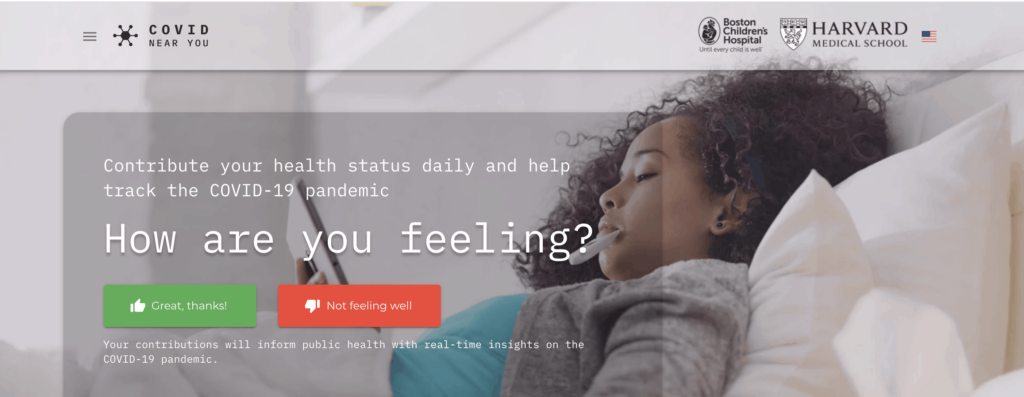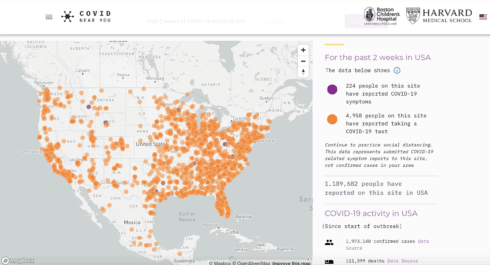How can you track the spread of COVID-19 in the absence of wide-scale testing?

Editor’s Note: This article originally appeared on the Cloudera Foundation website. In April 2021, the Cloudera Foundation merged with the Patrick J. McGovern Foundation.
by Nikita Japra
June 9, 2020
COVID Near You can promote health equity in tracing disease
When disease outbreak responders deal with a familiar pathogen, they have a head start on containment because reliable tests already exist to identify who is infected. Armed with lab-confirmed diagnostic test data, decision makers at all levels of the health system can pinpoint disease hotspots and send appropriate resources before clinics and hospitals are overwhelmed.
However, at the start of the COVID-19 pandemic, a test for the novel coronavirus that causes the disease had yet to be developed — stunting the global response. Even now, months after SARS-CoV-2 was first isolated and named, testing for COVID-19 remains limited in many parts of the world.
How can you track where the virus is spreading when you lack sufficient, reliable diagnostic test data?
According to a team at Boston Children’s Hospital, you can start by mapping crowdsourced, self-reported symptoms. Led by the hospital’s Chief Innovation Officer, computational epidemiologist John Brownstein, a cross-sectoral group of healthcare and data science experts developed a participatory symptom surveillance platform called COVID Near You to do just that.
“Global health actors already know how to contain outbreaks with evidence-based interventions, but it’s been a century since they’ve had to attempt it at this level of scale,” said Claudia Juech, CEO of the Cloudera Foundation. “The COVID Near You team is showing us in real-time how collective intelligence can bridge a gap when these known interventions need more time to take hold.”
Individuals can log onto the COVID Near You website to anonymously report their symptoms, periods of illness, and health-seeking behaviors alongside basic demographic and location data — enabling Brownstein’s team to map the results. In the absence of strong, scaled testing capacity, self-reported symptoms linked to specific zip codes can serve as a proxy signal for where cases are most likely to spike next. This utility is intended not only for the public health community at large, but also for those self-reporting the data. The average citizen can use the site to get a relative sense of how many people in their town might be fighting illness, even if the relevant health jurisdiction has yet to formally announce an outbreak.

The data collected are also analyzed by an in-house team of researchers seeking insights that can support ongoing pandemic response efforts at the local, state, and federal level. With the support of volunteers from tech companies like Amazon, Apple, and Google, COVID Near You launched in early April. It already has more than 750,000 users across the United States, Mexico and Canada, and will only become more powerful as its user base expands.
Though it’s early to determine the impact of COVID Near You, the platform could also prove to be an important tool to promote health equity: It has the potential to shine a light on populations that aren’t captured by conventional disease surveillance methods. Historically, disease surveillance has heavily relied upon data sourced from hospitals, labs, and outpatient clinics. This means that people who might truly be sick, but don’t seek care, aren’t captured by the system — so a community with zero test-confirmed cases might unknowingly harbor an elevated risk of infection.
“This is particularly important during a pandemic because people with milder symptoms may be less inclined to risk leaving their homes to get tested or seek medical care,” explained Kara Sewalk, a program manager at Boston Children’s Hospital.
The limitation matters not only because the undiagnosed can unwittingly infect others, but also because those who don’t seek care and forego testing may already be at a higher risk for more severe disease: They may be essential workers with increased opportunities for exposure to the virus, physically incapacitated, unable to pay for medical care, mistrustful of the health system, or fearful of lost wages. When those same people report their symptoms through COVID Near You, they can still provide a signal that there may be an active outbreak on the rise.
The added situational awareness provided by COVID Near You is not a panacea or a replacement for lab-confirmed diagnosis. It is also limited to capturing data from those with reliable access to the internet. However, it does augment the ability of local public health authorities to channel resources to vulnerable, previously unseen communities at risk. Health systems can use this collective intelligence to shore up supply chains, ramp up health promotion efforts to encourage testing, handwashing, and social distancing, or launch geo-targeted media campaigns to raise awareness of the threat.
Back at Boston Children’s Hospital, Sewalk says the team already has its eye on adapting their platform for other health threats and scenarios beyond the horizon.
“Our hope in the future is to continue to support this platform and see it grow, make improvements to the system and support public health in its surveillance needs.”
For more information:
- COVID Near You website
- White paper: Determinants of Participants’ Follow-Up and Characterization of Representativeness in Flu Near You, A Participatory Disease Surveillance System
- Kara Sewalk’s presentation to Cloudera Cares
Nikita Japra is the Senior Manager of the Data and Society Accelerator Program.